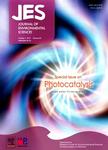Photocatalytic degradation of the diazo dye naphthol blue black in water using MWCNT/Gd,N,S-TiO_2 nanocomposites under simulated solar light
Photocatalytic degradation of the diazo dye naphthol blue black in water using MWCNT/Gd,N,S-TiO_2 nanocomposites under simulated solar light作者机构:Department of Applied Chemistry University of Johannesburg Faculty of Science DST-NRF Centre of Excellence in Strong Materials School of Physics University of the Witwatersrand Nanotechnology and Water Sustainability Unit College of Engineering Science and Technology University of South Africa Florida Campus
出 版 物:《Journal of Environmental Sciences》 (环境科学学报(英文版))
年 卷 期:2015年第27卷第7期
页 面:219-228页
核心收录:
学科分类:083002[工学-环境工程] 0830[工学-环境科学与工程(可授工学、理学、农学学位)] 07[理学] 08[工学] 070205[理学-凝聚态物理] 080501[工学-材料物理与化学] 0805[工学-材料科学与工程(可授工学、理学学位)] 0702[理学-物理学]
主 题:Gadolinium MWCNTs NBB Simulated solar light Tridoped titania
摘 要:A simple sol-gel method was employed to prepare gadolinium, nitrogen and sulphur tridoped titania decorated on oxidised multiwalled carbon nanotubes(MWCNT/Gd,N,S-Ti O2), using titanium(IV) butoxide and thiourea as titanium and nitrogen and sulphur source, respectively. Samples of varying gadolinium loadings(0.2%, 0.6%, 1.0% and3.0% Gd3+) relative to titania were prepared to investigate the effect of gadolinium loading and the amounts of carbon nanotubes, nitrogen and sulphur were kept constant for all the samples. Furthermore, the prepared nanocomposites were evaluated for the degradation of naphthol blue black(NBB) in water under simulated solar light irradiation. Higher degradation efficiency(95.7%) was recorded for the MWCNT/Gd,N,S-Ti O2(0.6% Gd)nanocomposites. The higher photocatalytic activity is attributed to the combined effect of improved visible light absorption and charge separation due to the synergistic effect of Gd,MWCNTs, N, S and Ti O2. Total organic carbon(TOC) analysis revealed a higher degree of complete mineralisation of naphthol blue black(78.0% TOC removal) which minimises the possible formation of toxic degradation by-products such as the aromatic amines. The MWCNT/Gd,N,S-Ti O2(0.6% Gd) was fairly stable and could be re-used for five times,reaching a maximum degradation efficiency of 91.8% after the five cycles.



